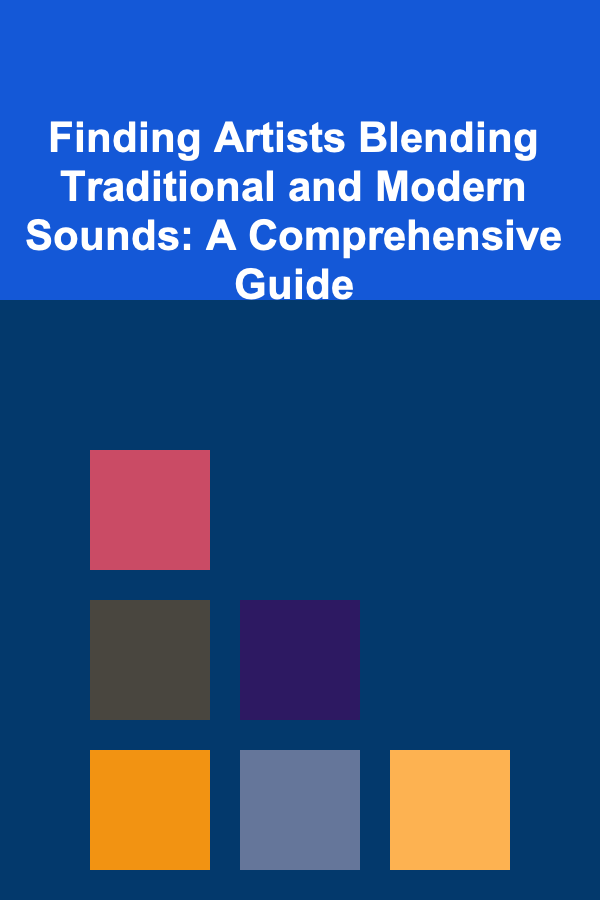
Finding Artists Blending Traditional and Modern Sounds: A Comprehensive Guide
ebook include PDF & Audio bundle (Micro Guide)
$12.99$5.99
Limited Time Offer! Order within the next:

In an era of unprecedented technological advancement and globalization, the preservation and reimagining of cultural heritage have become increasingly important. One powerful manifestation of this is the burgeoning trend of artists seamlessly blending traditional sounds with modern musical elements. These artists not only honor their roots but also create innovative and compelling soundscapes that resonate with a global audience. Finding these musical innovators, however, requires a proactive and multifaceted approach. This guide explores various strategies and resources to help you discover artists who are successfully bridging the gap between tradition and modernity in their music.
Understanding the Fusion: Defining "Traditional" and "Modern"
Before embarking on a search, it's crucial to define what we mean by "traditional" and "modern" in the context of music. "Traditional" encompasses a wide range of musical elements, including:
- Instrumentation: This refers to the use of instruments that are historically and culturally significant to a particular region or community. Examples include the sitar in Indian classical music, the kora in West African music, the bagpipes in Scottish music, or the didgeridoo in Australian Aboriginal music.
- Scales and Melodies: Traditional music often utilizes specific scales, modes, and melodic patterns that are characteristic of its origin. These musical structures are often passed down through generations and carry cultural significance.
- Rhythmic Structures: Traditional rhythms can be complex and nuanced, reflecting the dances, ceremonies, and social structures of the culture. They may involve specific time signatures, polyrhythms, and syncopation that are unique to the tradition.
- Lyrical Content and Language: The lyrics of traditional songs often tell stories, convey moral lessons, or express cultural values. The language in which the songs are sung is also a key element of tradition.
- Vocal Styles: Traditional singing styles can vary greatly depending on the culture, ranging from guttural throat singing to melodic yodeling. These styles often require specialized training and techniques.
"Modern" in this context refers to the incorporation of contemporary musical elements such as:
- Electronic Instruments and Production Techniques: This includes the use of synthesizers, drum machines, samplers, and other electronic instruments, as well as modern recording and mixing techniques.
- Western Harmony and Song Structures: The influence of Western pop, rock, and classical music is often evident in the use of chord progressions, song structures, and arrangements.
- Genre Fusion: Many artists blend traditional music with contemporary genres such as hip-hop, electronic music, jazz, or R&B.
- Modern Lyrical Themes: While traditional lyrics often focus on cultural stories and values, modern lyrics may address contemporary social issues, personal experiences, or philosophical themes.
The most compelling artists are those who don't simply juxtapose traditional and modern elements but rather create a seamless and innovative fusion. They understand the nuances of both traditions and use them to create something entirely new and exciting.
Strategies for Discovery: Where to Find These Artists
Finding artists who expertly blend traditional and modern sounds requires a strategic and diverse approach. Here are several effective methods:
1. Online Music Platforms: Streaming Services and Digital Music Stores
Streaming services like Spotify, Apple Music, Deezer, Tidal, and YouTube Music are invaluable resources for discovering new music. Utilize these platforms' search functions and algorithmic recommendations.
- Keyword Searches: Experiment with a variety of keywords that combine traditional instruments, genres, and regions with modern musical terms. For example, try searches like "Indian electronica," "African house music," "Celtic hip-hop," "Mongolian throat singing electronica," or "Andean downtempo." Be specific! The more targeted your search, the better your results will be.
- Genre Exploration: Look for genres that are known for incorporating traditional elements, such as world music, global beats, ethno-electronic, or contemporary folk. Explore the subgenres within these categories.
- Algorithmic Recommendations: Pay attention to the "Discover Weekly," "Release Radar," and similar algorithmic playlists on streaming services. These playlists are often tailored to your listening habits and can expose you to artists you might not otherwise find.
- Related Artists: When you find an artist you like, explore the "related artists" section on their profile. This can lead you to similar artists who are also blending traditional and modern sounds.
- Curated Playlists: Search for playlists curated by music bloggers, journalists, or other enthusiasts who specialize in this type of music. These playlists often feature a diverse range of artists and styles.
- Digital Music Stores: Platforms like Bandcamp and iTunes offer a wider selection of independent and world music than some streaming services. Explore their genre categories and artist recommendations.
For example, searching "Celtic electronica" on Spotify might lead you to artists like Talisk, who blend traditional Celtic melodies with electronic beats. Exploring their "related artists" could then introduce you to other bands in the contemporary Celtic folk scene.
2. Radio: Terrestrial and Online
Despite the rise of streaming, radio remains a powerful medium for discovering new music. Seek out radio stations that specialize in world music, folk music, or electronic music, or that have dedicated programs focusing on global sounds.
- Local Radio Stations: Some local radio stations, particularly those associated with universities or community organizations, may feature programs that showcase music from around the world.
- National Public Radio (NPR) and Similar Organizations: NPR in the United States and similar public radio organizations in other countries often have programs that highlight global music and cultural trends.
- Online Radio Stations: Numerous online radio stations specialize in world music, electronic music, or genre-bending sounds. Examples include SomaFM's Groove Salad World, KEXP (Seattle), and Worldwide FM.
- Podcast Music Shows: Many music podcasts focus on specific genres or regions. Look for podcasts that discuss world music, electronic music, or the intersection of the two.
Tuning into a program like NPR's "All Songs Considered" or a world music program on a local radio station could expose you to artists you wouldn't find through algorithmic recommendations alone.
3. Music Blogs and Online Publications
Music blogs and online publications are essential for staying informed about new releases, emerging artists, and trends in the music industry. Focus on publications that cover world music, electronic music, or independent music scenes.
- Specialized Blogs: Look for blogs that focus specifically on the intersection of traditional and modern music. These blogs often feature in-depth reviews, interviews, and artist profiles.
- General Music Blogs: Many general music blogs also cover world music and electronic music, although you may need to search specifically for articles related to the fusion of these genres.
- Online Music Magazines: Publications like Pitchfork, Resident Advisor, and The Wire often feature articles on artists who are pushing boundaries and experimenting with new sounds.
- University and Academic Publications: Scholarly articles sometimes cover little-known artists and movements that are not found in the general media.
Reading a review of a new album by an artist blending traditional Moroccan Gnawa music with electronic beats in a blog like "Okayafrica" or "Bandcamp Daily" could spark your interest and lead you to discover more artists in that genre.
4. Social Media: Connecting with Artists and Fans
Social media platforms like Facebook, Instagram, Twitter, and TikTok are valuable tools for connecting with artists, fans, and music communities. Follow artists you like, join relevant groups, and use hashtags to discover new music.
- Artist Pages: Follow your favorite artists on social media to stay up-to-date on their latest releases, tour dates, and news.
- Fan Communities: Join Facebook groups or online forums dedicated to specific genres or regions of music. These communities are often a great source of recommendations and discussions.
- Hashtags: Use relevant hashtags to discover new music and connect with other fans. Examples include #worldmusic, #globalbeats, #ethnotronica, #traditionalelectronic, #fusionmusic, and #worldmusicfusion.
- TikTok: TikTok is rapidly becoming a powerful music discovery tool. Use it to find trending music, artists, and sounds.
- Instagram: Many artists use Instagram to showcase their work and connect with fans. Look for artists in relevant genres and engage with their content.
Following an artist on Instagram might lead you to discover that they're collaborating with a traditional instrumentalist from their home country, which could then expose you to a whole new world of music.
5. Live Music: Festivals, Concerts, and Local Gigs
Attending live music events is a great way to experience the energy and authenticity of artists who are blending traditional and modern sounds. Look for festivals, concerts, and local gigs that feature world music, electronic music, or fusion genres.
- World Music Festivals: Many countries host world music festivals that showcase artists from around the globe. These festivals are a great opportunity to discover new music and experience different cultures.
- Electronic Music Festivals: Some electronic music festivals are starting to incorporate more world music and fusion acts into their lineups.
- Local Concert Venues: Check out local concert venues and clubs that feature independent and world music artists.
- University and College Events: Colleges and universities often host performances by world music artists.
Attending a world music festival like WOMAD (World of Music, Arts and Dance) could expose you to a diverse range of artists from different countries, many of whom are blending traditional and modern sounds.
6. Cultural Institutions and Organizations
Museums, cultural centers, and organizations dedicated to preserving and promoting traditional music can be valuable resources for discovering artists who are innovating within those traditions.
- Ethnomusicology Departments at Universities: These departments often conduct research on and promote traditional music from around the world.
- Cultural Centers: Many cities have cultural centers that host performances and workshops related to traditional music and culture.
- Museums: Some museums have exhibits or programs that feature traditional music and its contemporary adaptations.
- UNESCO: UNESCO often funds projects that promote cultural heritage, including music. Explore their resources for possible artists.
Contacting the ethnomusicology department at a local university could lead you to researchers or students who are studying artists blending traditional and modern sounds in a specific region.
7. Collaborations and Cross-Cultural Projects
Pay attention to collaborations between artists from different cultural backgrounds or genres. These projects often result in unique and innovative musical fusions.
- Cross-Genre Collaborations: Look for collaborations between electronic music producers and traditional instrumentalists or vocalists.
- International Projects: Some organizations fund international musical collaborations that bring together artists from different countries.
- Film and Documentary Soundtracks: Many films and documentaries that feature world music also feature artists who are blending traditional and modern styles.
Discovering that a well-known electronic music producer has collaborated with a Tuvan throat singer could lead you to explore the work of both artists and discover other similar collaborations.
Evaluating the Fusion: Recognizing Authenticity and Innovation
Once you've discovered potential artists, it's important to critically evaluate their work to determine whether they are successfully blending traditional and modern sounds in a meaningful and authentic way. Consider the following factors:
1. Respect for the Tradition:
Does the artist demonstrate a deep understanding and respect for the traditional music they are incorporating? Are they treating the tradition as a source of inspiration, or are they simply appropriating it for commercial gain? Authenticity involves more than just using traditional instruments; it requires understanding the history, cultural context, and meaning behind the music.
2. Innovation and Creativity:
Is the artist creating something truly new and innovative, or are they simply rehashing old ideas? A successful fusion should not only honor the past but also push boundaries and explore new possibilities. Look for artists who are experimenting with new sounds, textures, and arrangements.
3. Balance and Integration:
Are the traditional and modern elements balanced and integrated seamlessly, or do they feel disjointed and forced? A good fusion should feel natural and organic, with each element complementing and enhancing the other. The artist should masterfully weave both components into a cohesive whole.
4. Cultural Sensitivity:
Is the artist being culturally sensitive in their approach to traditional music? Are they aware of the potential for cultural appropriation or misrepresentation? Artists should engage with traditions respectfully and ethically, and avoid perpetuating harmful stereotypes.
5. Artistic Vision:
Does the artist have a clear artistic vision that drives their fusion of traditional and modern sounds? Are they using the music to express something meaningful or to explore a particular theme? Look for artists whose work is driven by passion, creativity, and a desire to connect with audiences on a deeper level.
Ultimately, the best way to evaluate the fusion of traditional and modern sounds is to listen critically and trust your own ears. If the music resonates with you on an emotional and intellectual level, then it is likely that the artist has achieved a successful and meaningful fusion.
Conclusion: Embracing the Global Soundscape
The search for artists blending traditional and modern sounds is a rewarding journey that can lead you to discover a wealth of musical innovation and cultural richness. By utilizing the strategies and resources outlined in this guide, you can expand your musical horizons and support artists who are pushing boundaries and creating a truly global soundscape. Embrace the diversity and creativity of these artists, and let their music transport you to new and exciting places.
The fusion of traditional and modern music represents more than just a musical trend; it's a cultural phenomenon that reflects the interconnectedness of our world and the ongoing dialogue between tradition and innovation. By actively seeking out and supporting these artists, we can help to preserve and celebrate cultural heritage while also fostering creativity and understanding across cultures. The world is a vast and vibrant tapestry of sounds, waiting to be discovered.
Reading More From Our Other Websites
- [Organization Tip 101] How to Use a Whiteboard for Effective Project Management
- [Whitewater Rafting Tip 101] From Adventure to Entrepreneurship: Starting Your Own Rafting Business
- [Trail Running Tip 101] Essential Gear for Beginner Trail Runners: Getting Started on the Path
- [Personal Finance Management 101] How to Choose the Right Health Insurance Plan for Your Needs
- [Trail Running Tip 101] Fueling the Fire: Essential Gear and Mindset for Passionate Trail Runners
- [Personal Care Tips 101] How to Make Your Foundation Last All Day
- [Home Space Saving 101] How to Design a Compact Home Gym Featuring the Best Foldable Exercise Equipment
- [Personal Finance Management 101] How to Track Expenses Using Only a Notebook & Pen
- [Personal Investment 101] How to Make Money by Automating Tasks with Deep Learning Models
- [Personal Investment 101] How to Use Investment Apps to Manage Your Portfolio

How to Create a Checklist for Performance Improvement Action Plans
Read More
How to Use Social Media to Promote Your Rental Property
Read More
How To Pick Books for a Cozy Afternoon Read
Read More
How to Safely Use Messaging Apps
Read More
10 Tips for Using Reverb Effectively
Read More
How to Sell Printable Activity Books on Etsy: A Beginner's Guide
Read MoreOther Products

How to Create a Checklist for Performance Improvement Action Plans
Read More
How to Use Social Media to Promote Your Rental Property
Read More
How To Pick Books for a Cozy Afternoon Read
Read More
How to Safely Use Messaging Apps
Read More
10 Tips for Using Reverb Effectively
Read More